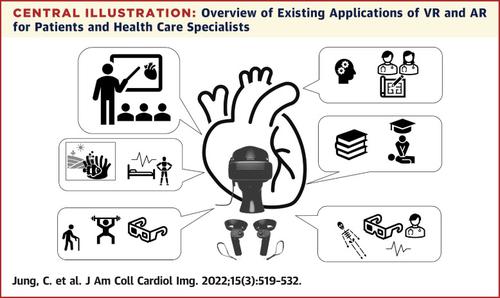JACC: Cardiovascular Imaging ( IF 12.8 ) Pub Date : 2021-10-13 , DOI: 10.1016/j.jcmg.2021.08.017 Christian Jung 1 , Georg Wolff 1 , Bernhard Wernly 2 , Raphael Romano Bruno 1 , Marcus Franz 3 , P Christian Schulze 3 , Jennifer N Avari Silva 4 , Jonathan R Silva 5 , Deepak L Bhatt 6 , Malte Kelm 7

|
Applications of virtual reality (VR) and augmented reality (AR) assist both health care providers and patients in cardiovascular education, complementing traditional learning methods. Interventionalists have successfully used VR to plan difficult procedures and AR to facilitate complex interventions. VR/AR has already been used to treat patients, during interventions in rehabilitation programs and in immobilized intensive care patients. There are numerous additional potential applications in the catheterization laboratory. By using AR, interventionalists could combine visual fluoroscopy information projected and registered on the patient body with data derived from preprocedural imaging and live fusion of different imaging modalities such as fluoroscopy with echocardiography. Persistent technical challenges to overcome include the integration of different imaging modalities into VR/AR and the harmonization of data flow and interfaces. Cybersickness might exclude some patients and users from the potential benefits of VR/AR. Critical ethical considerations arise in the application of VR/AR in vulnerable patients. In addition, digital applications must not distract physicians from the patient. It is our duty as physicians to participate in the development of these innovations to ensure a virtual health reality benefit for our patients in a real-world setting. The purpose of this review is to summarize the current and future role of VR and AR in different fields within cardiology, its challenges, and perspectives.
中文翻译:

心血管护理中的虚拟现实和增强现实
虚拟现实 (VR) 和增强现实 (AR) 的应用可帮助医疗保健提供者和患者进行心血管教育,补充传统的学习方法。介入专家已经成功地使用 VR 来计划困难的程序,并使用 AR 来促进复杂的干预。VR/AR 已被用于治疗患者、康复计划干预期间和固定重症监护患者。在导管插入术实验室中还有许多其他潜在应用。通过使用 AR,介入医师可以将投射和记录在患者身体上的视觉透视信息与来自术前成像的数据以及不同成像方式的实时融合(如透视与超声心动图)相结合。需要克服的持续技术挑战包括将不同的成像模式集成到 VR/AR 中以及数据流和接口的协调。网络病可能会将一些患者和用户排除在 VR/AR 的潜在好处之外。在弱势患者中应用 VR/AR 时会出现关键的伦理考虑。此外,数字应用程序不得分散医生对患者的注意力。作为医生,我们有责任参与这些创新的开发,以确保我们的患者在现实世界中获得虚拟健康的好处。本综述的目的是总结 VR 和 AR 在心脏病学不同领域的当前和未来作用、挑战和前景。网络病可能会将一些患者和用户排除在 VR/AR 的潜在好处之外。在弱势患者中应用 VR/AR 时会出现关键的伦理考虑。此外,数字应用程序不得分散医生对患者的注意力。作为医生,我们有责任参与这些创新的开发,以确保我们的患者在现实世界中获得虚拟健康的好处。本综述的目的是总结 VR 和 AR 在心脏病学不同领域的当前和未来作用、挑战和前景。网络病可能会将一些患者和用户排除在 VR/AR 的潜在好处之外。在弱势患者中应用 VR/AR 时会出现关键的伦理考虑。此外,数字应用程序不得分散医生对患者的注意力。作为医生,我们有责任参与这些创新的开发,以确保我们的患者在现实世界中获得虚拟健康的好处。本综述的目的是总结 VR 和 AR 在心脏病学不同领域的当前和未来作用、挑战和前景。作为医生,我们有责任参与这些创新的开发,以确保我们的患者在现实世界中获得虚拟健康的好处。本综述的目的是总结 VR 和 AR 在心脏病学不同领域的当前和未来作用、挑战和前景。作为医生,我们有责任参与这些创新的开发,以确保我们的患者在现实世界中获得虚拟健康的好处。本综述的目的是总结 VR 和 AR 在心脏病学不同领域的当前和未来作用、挑战和前景。









































 京公网安备 11010802027423号
京公网安备 11010802027423号